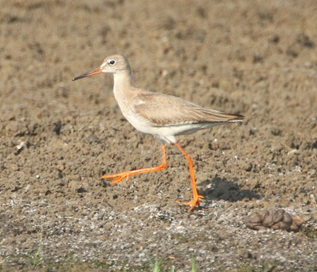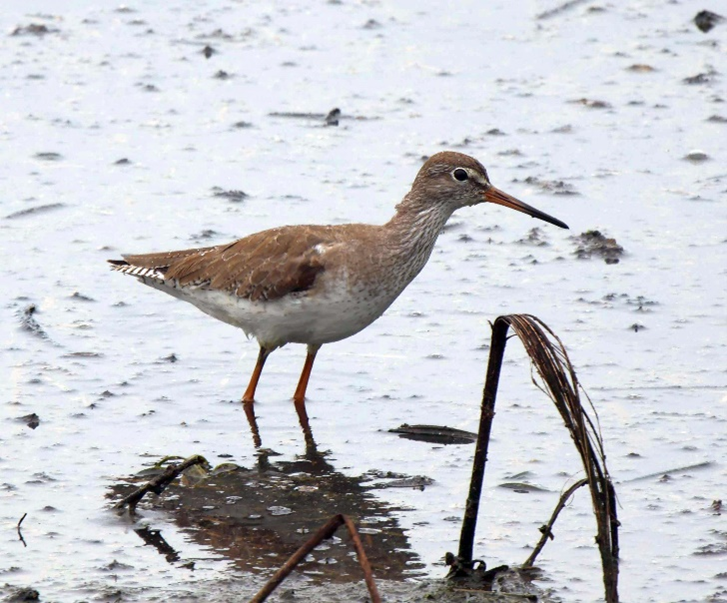A Redshank and a Waterbird Count at Huntley Farm, Chisamba, in January 2024

One of the real perks of living next door to Fringilla Lodge these days is that it takes me just 10 minutes to get to Huntley Farm. This is one of the best-known birding localities in central Zambia, for very good reasons. BirdWatch has been organising bird outings and conducting half-yearly waterbird counts here for many years now. It has also become my “homepatch” in the last 3 years, which I try to visit at least weekly in the migrant season – when home.
In contrast to the rest of the 2023-2024 ‘wet season’, there were very heavy rains during the last week of December. Huntley’s upper central dam and Wangwa Dam were overflowing, washing parts of the main road away, and creating excellent waterbird conditions. The middle of the central dams quickly filled with Lesser Moorhens and waders. I made an effort to visit the site frequently in January, which paid off. On 11 January, while birding with a few visiting fellow Dutchmen (Boena van Noorden, Wil Beeren, Paul Voskamp and Jan Biemans), I suddenly picked up on what unmistakably was a Redshank, standing out between the many Wood Sandpiper and Ruff despite being superficially rather similar. Picking up on it was easier than getting the other guys to appreciate the significance since this is a common bird in much of Europe. The rather uniform upper- and underparts form possibly the most useful fieldmark. The straight red bill, red legs and white wedge in the wing confirmed the identification. The bird would prove rather cooperative, in terms of it staying put at the dam up till 28 January, being often hidden in tall grass but calling and flying frequently. This allowed the many participants of the BirdWatch birdwalk on 21 January, and a few others on other dates, to connect with the bird, dramatically growing the member numbers of the “Redshank Club” (a term coined by Damian).
There was a flurry of records in the 1970s and 1980s following drought further north. Since 1993, however, we only had two confirmed Zambian records. Damian Newmarch noticed a bird at Kafue Fisheries on 18 October 2015. Wouter van Spijker found one at Clipper Fish Farm on 25 October 2023, together with Alastair Newton. There are many more claims, but available images suggest these were all male Ruff which can look pretty similar, with overlap in (orange-)red colouration of legs and bill. The perfectly straight, dark-tipped bill and white wing wedge of Redshank are however diagnostic, as is the call.
Redshank Tringa totanus is generally listed as “Common Redshank” but this obviously doesn’t make sense in many parts of the world including Zambia. At least two populations visit Africa. Nominate totanus (“European Redshank”) breeds in Europe and is a common visitor in Africa north of the equator. Race ussuriensis (“Siberian Redshank”) breeds widespread in Siberia, Mongolia and parts of China, with non-breeding areas including the Middle East and northeastern Africa. We had no information on the races that have been recorded in Zambia so far. Images of the Huntley bird are however a good match for totanus, while the Clipper bird has clearly different proportions with much longer legs and heavier bill base, and is paler in plumage, matching ussuriensis. This is a great illustration of how Zambia lies on the division between the flyways of western and eastern Africa! There are also some other races breeding further east in Asia, but identification is difficult and occurrence much less likely. Spotted Redshank Tringa erythropus also occurs in Africa, including (rarely) south of the equator. There’s a single, old report from Zambia, at Busanga Plains. They have longer legs, neck and bill than ussuriensis, but are easily distinguished on call and the absence of a white wing wedge.

“Siberian” Redshank Tringa totanus ussuriensis at Clipper Fish Farm, Livingstone, 25 October 2023 (Wouter van Spijker).

“European” Redshank Tringa totanus totanus at Huntley Farm, 11 January 2024 (Frank Willems).
I ended up only doing the January waterbird count on 31 January…. By which time the Redshank had disappeared! It was nevertheless a very enjoyable count with 6429 birds of 55 species counted, including some raptors and kingfishers and the like. Marabou is remarkably common here, with 1368 counted, though was outnumbered by Cattle Egret (2475). Lesser Moorhen was abundant with 234 counted, which doesn’t include the hundreds or thousands that will have been hiding in the flooded grasslands and reeds. A total of 125 Southern Pochard is notable, but this species and other ducks only peak here in about April when there might be some 500, and Knob-billed Duck numbers in the many thousands. For that, the timing of both the January and July counts certainly don’t coincide with peak bird numbers here!
Table: waterbirds at Huntley Farm, 31 January 2024.
| Species | Number counted | Species | Number counted | |
| Central dams | Rufous-bellied Heron | 5 | ||
| White-faced Whistling Duck | 407 | Squacco Heron | 27 | |
| Fulvous Whistling Duck | 8 | Western Cattle Egret | 2435 | |
| Spur-winged Goose | 5 | Great Egret | 28 | |
| Knob-billed Duck | 125 | Yellow-billed Egret | 2 | |
| Blue-billed Teal | 90 | Grey Heron | 11 | |
| Yellow-billed Duck | 5 | Hamerkop | 1 | |
| Red-billed Teal | 156 | Pink-backed Pelican | 48 | |
| Southern Pochard | 2 | Osprey | 1 | |
| Lesser Moorhen | 234 | White-backed Vulture | 9 | |
| Common Moorhen | 8 | Long-crested Eagle | 1 | |
| Red-knobbed Coot | 97 | Ayres’s Hawk-Eagle | 1 | |
| Allen’s Gallinule | 13 | African Marsh Harrier | 1 | |
| African Swamphen | 3 | African Fish Eagle | 4 | |
| Black Crake | 4 | Pied Kingfisher | 1 | |
| Little Grebe | 2 | |||
| Black-winged Stilt | 17 | Wangwa Dam | ||
| Blacksmith Lapwing | 250 | White-faced Whistling Duck | 10 | |
| African Wattled Lapwing | 4 | Fulvous Whistling Duck | 2 | |
| Greater Painted-snipe | 2 | White-backed Duck | 9 | |
| Lesser Jacana | 1 | Knob-billed Duck | 2 | |
| African Jacana | 33 | Blue-billed Teal | 3 | |
| Marsh Sandpiper | 2 | Yellow-billed Duck | 2 | |
| Wood Sandpiper | 220 | Red-billed Teal | 1 | |
| Ruff | 128 | Southern Pochard | 125 | |
| Whiskered Tern | 1 | Lesser Moorhen | 1 | |
| Marabou Stork | 1368 | Red-knobbed Coot | 2 | |
| Yellow-billed Stork | 1 | Little Grebe | 1 | |
| White Stork | 2 | African Darter | 4 | |
| African Darter | 11 | Reed Cormorant | 31 | |
| Reed Cormorant | 64 | Little Egret | 1 | |
| White-breasted Cormorant | 55 | Western Cattle Egret | 40 | |
| African Sacred Ibis | 27 | Grey Heron | 1 | |
| Glossy Ibis | 230 | European Honey Buzzard | 1 | |
| Black-crowned Night Heron | 2 | African Cuckoo-Hawk | 1 | |
| Little Egret | 28 | African Fish Eagle | 1 | |
| Rufous-bellied Heron | 9 | Malachite Kingfisher | 2 |
